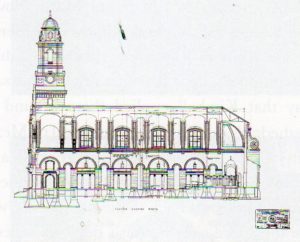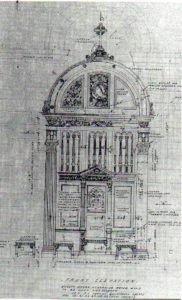Inspiration for the Cathedral Architecture
"Saint Cecilia Cathedral is firmly situated in a historical context that is far beyond that of Omaha and the region. In its form, the Cathedral is linked to the Greeks and Romans, the Renaissance, Philip II of Spain, and Colonial New Spain. It serves as a visual reference to the earliest explorations of these lands by the Spanish. As a metaphor, it calls to mind the Faith that served to inspire the deeds of countless generations."
~ Brother William Woeger, F.S.C.

In the final analysis, it is entirely conjecture as to exactly where Kimball drew inspiration for the Cathedral's design. With little clues remaining, aside from his known study and travel abroad, his Beaux-Arts classical education, his reference to having followed "Old Country conventions," and a short list of architectural pattern books in his own library, the rest is speculation. Kimball was the epitome of the historical eclectic approach to design at the turn-of-the-century in America, but eclecticism spans the history of architecture itself.
The borrowing of the Italian style evident in Spanish sixteenth-century architecture and the dependence, in turn of New Spain upon Spanish precedent, are themselves phenomena of such eclecticism.
The Bibilical book of Ecclesiastes reminds us that "nothing is new under the sun. Even the thing of which we say, 'See, this is new!' has already existed in the ages that preceded us." The same is almost true of art and architecture and Kimball is no exception.
~The Beauty of Thy House, 2005

Now (1981) ranked as one of the ten largest cathedrals in the United States, and listed on the National Register of Historic Places, Saint Cecilia's Cathedral has the outside dimensions of two hundred fifty-five feet in length, one hundred fifty-eight feet in width, and, at the extreme height of towers, two hundred twenty-two feet. The walls are of solid masonry throughout, with the exterior in off-white Bedford limestone of Indiana. The roof of Spanish tiles is supported on steel. No less than a hundred tons of steel was used to support the roof and floor. In the foundation are over a million pounds of concrete. Over three million bricks were used in the structure itself. The construction is absolutely fireproof.
~ Saint Cecilia's Cathedral, 1981
Saint Cecilia Cathedral was listed on the National Historic Register in 1979. The latest renovations were recognized with the A.I.A. Nebraska Architectural Honor Award in 2001 and Landmarks Preservation Award 1999.
